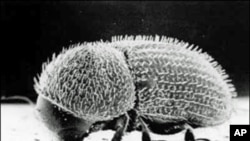A bacterial gene has somehow lept across the species barrier and landed in the genetic makeup of an insect.
While it's a mystery how the gene got there, it's been a big help to the insect.
The insect, called the coffee berry borer, is the bane of coffee plantations worldwide. It lives on nothing but coffee beans and causes about $500 million of damage every year.
Coffee researchers in Colombia were not looking for cases of cross-species gene swapping.
They were simply trying to figure out how the coffee berry borer drilled its way into the coffee bean.
They contacted Cornell University plant biologist Joss Rose, who had developed some scientific tools the Colombian researchers thought might help.
'Aha' moment
Working together, Rose says they discovered that the insect produces proteins in its gut that break down the main kind of sugar, or carbohydrate, that the coffee plant uses to store energy. Those sugars are called mannans, and the proteins that break it down are called mannanases.
“So we thought, ‘Aha. This is interesting,'" Rose says. "This looks like a potential mechanism. If this thing can have mannanases in its gut, it can digest the carbohydrates and chew its way in.”
Rose says there was just one problem.
“Insects don’t seem to have mannanases. We came across no other example in the literature or any of the DNA sequence databases of an insect that has a mannanase.”
Gut bacteria
Insects may not have these proteins, but the bacteria that live in their guts do.
Bacteria help all kinds of creatures - from insects to humans - digest their food. Rose and his colleagues thought maybe what they were seeing was just bacterial contamination.
But it wasn't.
“We confirmed through a number of different techniques that no, in fact, this gene actually is in the genome of the insect," he says, "and yet has all the signatures, all the sequence that looks exactly like a bacterial gene.”
How that bacterial gene got into the insect’s genetic material, or genome, is not clear, though Rose and his colleagues have a few ideas to test.
Enormous advantage
They think the beetle acquired the bacterial gene after humans domesticated the coffee bush and began growing it in larger plantations. With all those coffee beans around, Rose says, “anything that has a mannanase that allows it to drill into this bean [would] be at an enormous selective advantage.”
It certainly has been an advantage for the coffee berry borer. With the help of that bacterial gene, it can live on a diet based entirely on coffee beans.
Yale University evolutionary biologist Nancy Moran says these kinds of gene transfers may be rare but important events that help organisms adapt to new environments.
Not so unusual
Just a few years ago, she and her colleagues were studying another plant pest, the aphid. Aphids produce colored chemicals that serve as camouflage and sunscreen. The researchers discovered that the genes for the proteins that make those chemicals came from a fungus.
“There’s a tendency when people find something that seems very unusual and strange at first, often it does turn out that it’s not that unusual and that it’s actually more widespread,” she says.
It is unclear just how widespread it is. Moran says she does not know of any cases farther up the food chain - of genes jumping from microbes to mammals, for example. But for the coffee berry borer at least, a little bacterial DNA seems to have made all the difference.








